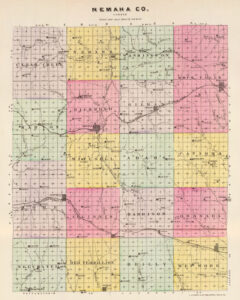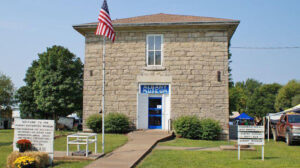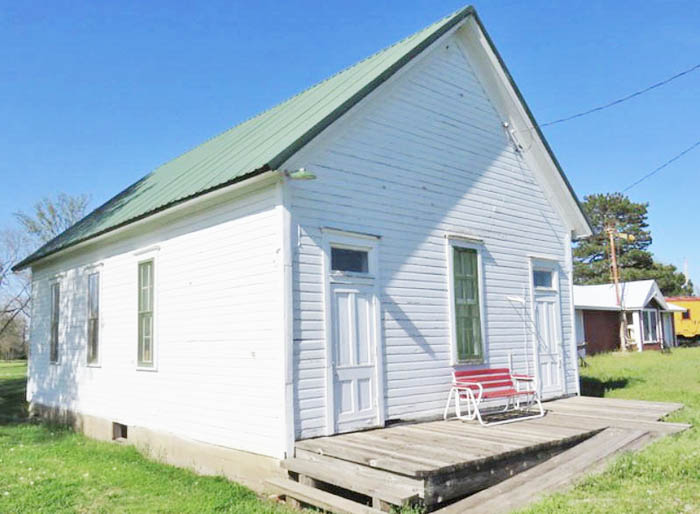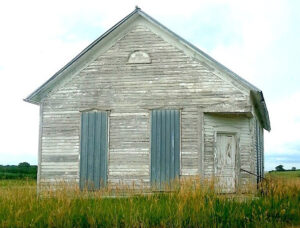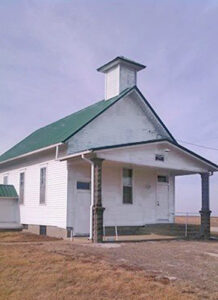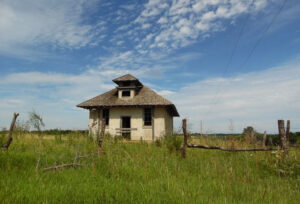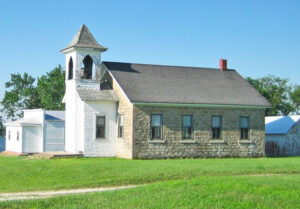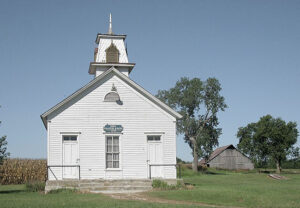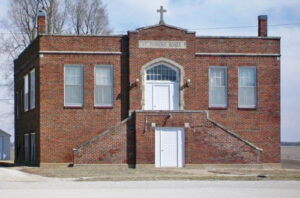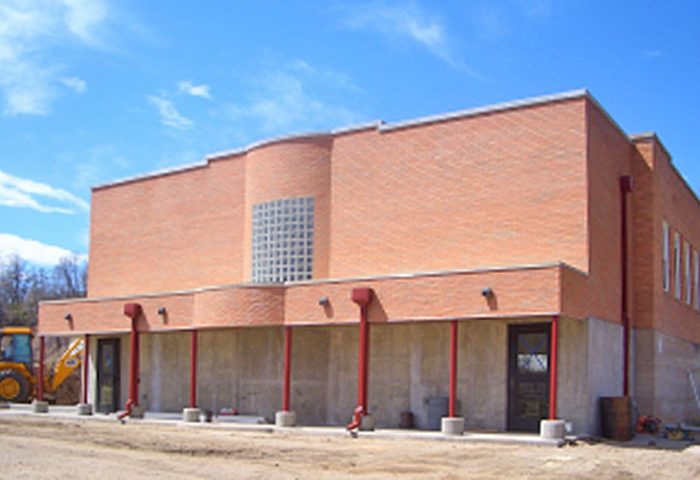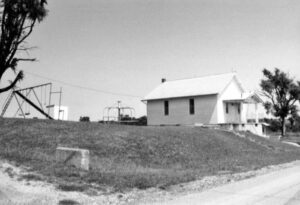The first school was taught in a small building in Granada Township of Nemaha County, Kansas, in 1856.
A school building was erected at America City, in Red Vermillion Township, in 1857.
In the fall of 1858, the first school in Seneca was taught by Miss Addie Smith in the hotel building erected by John E. Smith. The school district was not organized until some years later.
The early educational history of Nemaha County was blended with that of Centralia. In 1858, T.P. Coan of Clayton, Illinois, N. B. McKay of Galesburg, Illinois, and one other gentleman were sent to Kansas by the “Home Association” of Galesburg, Illinois, “to select a township of land to be settled by neighbors, friends, and acquaintances.” Centralia was laid out, and provisions were made to support schools and churches. The plan provided for a section at the township’s center to be laid out in town lots ranging from 2.5 to 10 acres. The sale proceeds were to endow a college. Provisions were made for eight other school districts in the township. In 1859-60, a two-story frame building was erected on the town site for school and religious purposes.
The first school in Central City was under the charge of Mahlon Pughin in 1859.
Another early school in the county was a private one taught by Miss Ada Smith in Seneca in 1859. A log schoolhouse built about four miles south of Seneca in the fall of 1859 was probably the first schoolhouse built in the county.
Centralia was organized as District No. 1, Riverside as District No. 2, and Seneca as District No. 3. Districts were organized rapidly afterward.
The first report of school matters in Nemaha County was made in 1860 by J.C. Hebbard, the County Superintendent, to Samuel W. Greer, the Territorial Superintendent of Public Instruction. This report shows that in the county at that time, there were 180 people between the ages of five and twenty-one years, six organized school districts, and the same number of schools being taught.
In 1861, Reverend Daniel Foster, a Unitarian minister from Boston, Massachusetts, and a graduate of Dartmouth College, in conjunction with F.P. Baker and others, obtained a charter for the organization of Centralia College. Reverend Foster opened the school with 60 students and continued it until the spring of 1862, when, through unfortunate wrangling, which resulted in forming two factions, one party took the door and window frames out of the building, compelling the school to vacate the building. The school was continued, however, in the law office of F.P. Baker for a month, when the doors and windows were restored, before moving a family into the house. The faction in favor of continuing the school rallied, took possession of the building, and guarded it with guns and revolvers one day while both parties sent emissaries searching for the sheriff. The messenger of the opposition faction found him first and got warrants into his hands for the arrest of 23 members of the school faction, charging them with rioting. They were taken to Seneca and, after a week of preliminary examination, were bound over for trial at the next term of the district court. They were subsequently tried and acquitted. But the trouble killed Centralia College, ending one of Kansas’s earliest attempts at higher education. That which promised to be a flourishing school was cut off at the very beginning of its usefulness.
As early as 1864, a teachers’ association was organized with T.D. Shepherd, President; Abijah Wells, Secretary; and William Histed, Treasurer.
The School Board of District 11 advertised on April 21, 1864, for proposals to build a one-story brick schoolhouse in Seneca. The contract was let early in May to L.J. McGowen and George Monroe. This building, 24×50 feet in size, was erected for $1,700 and was first occupied in the spring of 1865, the school then being under the charge of Abijah Wells and Miss Kate Webber. The building was used for the purpose it was designed until 1869, when it was found inadequate to meet the increased demands of the school population. The board, foreseeing this, advertised in April 1868 for bids for a new and much larger edifice, the contract for which was let to C. G. Scrafford, and the building completed the year following, the old schoolhouse being sold to the Catholic Society for church purposes. As originally erected, the new building was of stone, 45×561/2 feet, two stories in height, and with a bell tower and pinnacle 66 feet above the surface.
In 1876, the courthouse was destroyed by fire, and all the records of the county superintendent’s office were burned, so it isn’t easy to ascertain much of the early educational history of Nemaha County.
In 1880, the county had a school population of 4,473, with 86 organized districts with 90 schoolhouses. The schools gave employment to 133 teachers. The total valuation of the school property at this time was $57,904.
By the early 1890s, there were 115 districts and 12 joint districts.
Historic Schools
| Name | District | Years of Operation | Location & Information |
| Albany | Albany District 1 N. and B | 1867-1862 |
The old two-story limestone Albany School was built in 1866-1867 in the old town of Albany, Kansas. Today, it is part of the Albany Museum Complex. The lower portion of the building was erected by the school district for use as a school, and the upper portion was completed through the efforts of the Congregational Society, which used it for many years as a place of worship. Men of the community hauled limestone from a quarry one-fourth mile southeast of the school site, and two masons were hired to lay the stone. Also using the upper floor was the Albany Academy, which operated for about ten years in the 1860s and 1870s and attracted high school-age students from Kansas, Nebraska, and Missouri. During the peak years, the one-teacher elementary school on the lower floor had as many as 70 students; the Academy reportedly had 50 to 60 students each term. The school continued in Albany until 1962, when the students were furnished transportation to the Sabetha schools. The Albany Historical Society was established in July 1965, and the schoolhouse and grounds were transferred to it several months later. Following renovation work, the school is now maintained as a museum. Several other buildings of local historic interest have been relocated on the school grounds one-half mile west of US-75, two miles north of Sabetha at 2441 204th Road. |
| Berwick | 62 | ?? |
The Berwick school building near Albany, Kansas, was acquired and moved to the Albany Museum Complex in 1966. It is one-half mile west of US-75, two miles north of Sabetha at 2441 204th Road. Albany, Kansas, is an extinct town about two miles north of Sabetha in Berwick Township. There is not much left of the town, but it is the site of the Old Albany Schoolhouse Museum. |
| Clear Creek | 27 | ?? |
This school is on the “Baileyville Road” north of Baileyville. It is on 216th Road, adjacent to Township Road E. One way to get there is to take 232 Road westbound from Highway 8 and go to the next black top. Turn left, and you will come to the school from behind. |
| Concord | 104 | ?? | |
| Excelsior | 111 | ?? |
The old Excelsior School is located in Berwick Township near the extinct village of Berwick, Kansas. The school still displays old playground equipment. |
| Morning Star | 57 | ?? |
Morning Star in Granada Township is southeast of Seneca. |
| Neuchatel | 5 | 1871-1951 |
The Neuchatel School, made of native stone, was established in 1871. It replaced an earlier log school that had been built in 1863. The school closed during the winter of 1951. It continues to stand today next to the Neuchatel village hall. |
| Prairie Grove | 65 | 1886-1963 |
The school was built in 1886, expanding the existing frame schoolhouse and adding a stage, cloakroom, and a chimney for a coal stove. Built of clapboard siding, it has a short wood-frame bell tower capped with a mansard-roof belfry crowned by an ornate flagpole with weathervane. Access to the classroom is gained through the girls’ or boys’ cloakroom. All ages of children were taught in the school. During the school term of 1897-98, the enrollment reached 63. In May 1963, Prairie Grove was unified with the Bern Public School District 92. Afterward, it served the alumni association for several years. There is a storm cellar on the northwest corner of the property. The school was listed on the National Register of Historic Places in 2006. It is located ten miles north of Seneca at 2991 H Road. |
| St. Patrick’s Catholic School | NA | 1920-?? |
This one-and-a-half-story rectangular brick building was designed in the Collegiate Gothic style with a flat roof and parapet. Its present use is unknown. It is located at 6606 Atlantic Street in Corning, Kansas. |
| Wetmore | ?? | 1928-1861 |
The Wetmore school building was completed in 1928 and was used as the Wetmore schoolhouse until the fall of 1961 when the district consolidated with the Florence school district. Grades 1-8 were held in various rooms of the building. There is some question as to whether grades 9-12 were held there. The outhouses were 30 feet northwest of the building. Electricity was installed in the North Room in the 1940s thanks to the GI Bill. The rest of the building received electricity around 1955. The original heat was from a coal furnace. Bathrooms were built in 1958-1959. The building now serves as the Wetmore Community Center and Library |
| Woodlawn | 24 | 1920-?? |
District #24 records go back to 1883, two years after Atchison physician W.L. Challis platted the town of Woodlawn, expecting a railroad to pass through the township. This appears to be a second-generation structure. This one-story wood frame rectangular building was designed in the vernacular style with a gable-front roof. Today, the building serves as a community center and site for an annual homecoming. The site still displays playground equipment. It is located on 120 Road, three miles east of the extinct town of Woodlawn, Kansas, in Capioma Township. |
Historic School Districts
| School Name | District | School Name | District | |
| Albany | 1 N. and B. | Maple Shade | 49 | |
| Armstrong | 55 | Marion | 59 | |
| Aurora | 14 | Mentor | 5 | |
| Axtell | 17 | Morning Star | 57 | |
| Baileyville | 94 | Morning Star | 79 | |
| Bancroft | 31 | Mt. Union | 34 | |
| Belleview | 56 | Mt. Vernon | 66 | |
| Benedict | 33 | Mulberry | 36 | |
| Bern | 92 | Oak Grove | 103 | |
| Berwick | 62 | Obendorf | 41 | |
| Bethany | 39 | Old Lincoln | 22 | |
| Blue Star | 58 | Oneida | 87 | |
| Boardman | 45 | Ontario | 2 N. and J. | |
| Capioma | 25 | Pinckney | 61 | |
| Carroll | 6 | Pleasant Hill | 10 | |
| Center | 76 | Pleasant Hill | 13 | |
| Centralia | 1 | Pleasant Hill | 18 | |
| Clear Creek | 27 | Pleasant Hill | 73 | |
| Cleveland | 74 | Pleasant Ridge | 26 | |
| Cole Creek | 53 | Pleasant Ridge | 71 | |
| College Hill | 81 | Pleasant Ridge | 91 | |
| Concord | 104 | Pleasant View | 54 | |
| Corning | 44 | Pleasant View | 70 | |
| Cottonwood | 95 | Prairie Grove | 65 | |
| Diamond | 88 | Prairie Star | 82 | |
| Domer | 97 | Prairie View | 69 | |
| Eagle Star | 32 | Riverside | 2 | |
| Eclipse | 90 | Rock | 68 | |
| Edgewood | 46 | Rock Creek | 78 | |
| Ehrsam | 64 | Rogers | 28 | |
| Eureka | 30 | Rose Hill | 19 | |
| Eureka | 43 | Sabetha | 51 | |
| Evening Star | 85 | Seneca | 11 | |
| Fairview | 37 | Sherman | 89 | |
| Flag | 29 | Social Hill | 50 | |
| Ford | 4 | Social Hill | 72 | |
| Forward | 100 | Star | 67 | |
| Goff | 86 | Summit | 80 | |
| Graham | 3 | Shady Knoll | 98 | |
| Granada | 6 N. and B. | Sunny Knoll | 93 | |
| Grand View | 96 | Swerdfeger | 12 | |
| Greenwood | 35 | Tranquil | 63 | |
| Harmony | 75 | Triumph | 16 | |
| Harris | 42 | Union | 8 | |
| Hazel Grove | 60 | Union | 9 | |
| Head | 38 | U.S. Grant | 101 | |
| Hilt | 84 | Victor | 99 | |
| Humphrey | 23 | Victory | 20 | |
| I. X. L. | 40 | Victory | 83 | |
| Johnstone | 47 | Westmore | 1 N. and J. | |
| Kelly | 21 | White Hall | 7 | |
| Korber | 52 | Willow Glen | 77 | |
| Liberty | 15 | Windy Ridge | 1 N. and M. | |
| Liberty | 102 | Woodlawn | 24 | |
| Maple Ridge | 48 |
©Kathy Alexander/Legends of Kansas, December 2023.
Also See:
One-Room, Country, & Historic Schools of Kansas
Sources:
Kansas Historic Resources Inventory
Kansas State Historical Society, The Columbian History of Education in Kansas, Hamilton Printing Company, Topeka, KS, 1893
Rootsweb


